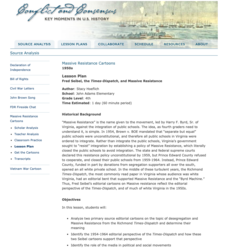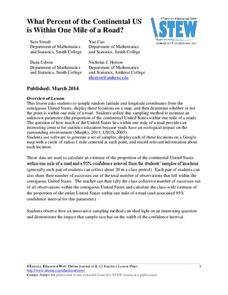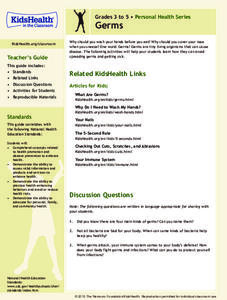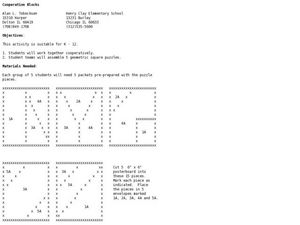Virginia Department of Education
Molar Heat of Fusion for Water
How can you describe heat of fusion in a way the class understands and relates the importance of this concept to present day issues? In this third lesson of the series, learners conduct an experiment, demonstrating the flow of heat...
EngageNY
Truncated Cones
Learners examine objects and find their volumes using geometric formulas in the 21st installment of this 25-part module. Objects take the shape of truncated cones and pyramids, and individuals apply concepts of similar triangles to find...
EngageNY
Reading Proficiently and Independently: The Power of Setting Goals
Scholars reflect upon their reading strengths and challenges to create personal reading goals. Participants use goal-setting verbiage in an accordion-style graphic organizer, a first step in writing a letter that details their reading...
Roy Rosenzweig Center for History and New Media
Fred Seibel, the Times-Dispatch, and Massive Resistance
A lesson challenges scholars to analyze editorial cartoons created by Fred Seibel, illustrator for the Times-Dispatch, during the Massive Resistance. A class discussion looking at today's editorial pages and Jim Crow Laws leads the...
Statistics Education Web
What Percent of the Continental US is Within One Mile of a Road?
There are places in the US where a road cannot be found for miles! The lesson asks learners to use random longitude and latitude coordinates within the US to collect data. They then determine the sample proportion and confidence interval...
K20 LEARN
Do Placebos Kill Minotaurs?
But it's just a game! Learners play a game to learn basic concepts of statistical hypothesis testing. After using the digital-game module, pupils develop their own statistical hypotheses and test them.
K20 LEARN
Didn’t We Already Learn That Pattern? Functions/Arithmetic Sequences
Just how many toothpicks does the pattern take? After watching a video of someone building a pattern with toothpicks, groups create methods to find the number of toothpicks needed to accomplish that task. Groups either use explicit...
Nemours KidsHealth
Germs: Grades 3-5
Infection prevention is the focus of two lessons. In instructional activity one, scholars take a brief quiz, survey peers, and discuss prevention techniques to stay healthy. Lesson two examines how germs work—transmission, symptoms,...
Health Smart Virginia
Mindfulness Yoga
Standing pose, tree pose, warrior pose, easy pose. Middle schoolers learn several basic yoga exercises and poses that can help them relax. They also keep a four-week stress log to track stressful situations and how they dealt with them.
Curated OER
Teaching Students to Run Their Own IEP Meetings
Students who have IEP's for emotional/behavioral disorders are trained how to participate in and even conduct their own IEP meetings. They study the purpose of the IEP, definitions of special ed. related concepts, and the components of...
Curated OER
Tuck Everlasting: UDL Team Lesson Plan
Students participate in a differentiated lesson about Tuck Everlasting. In this Tuck Everlasting lesson, students work on comprehension strategies that are leveled for their reading ability. They focus on the ability to tell the main...
Curated OER
Locomotor Letters (Numbers or Shapes)
Young scholars practice a variety of locomotor skills and integrate the writing of numbers, letters and shape drawing. Done with music.
Curated OER
Making Circle Graphs
Seventh graders engage in the practice of a Math lesson. Students practice the use of circle graphs in class and on homework as an extension. The lesson includes a classroom management portion. The assignment for the lesson is for the...
Curated OER
Punch Mix-up
Fifth graders discuss the relationship between equivalent fractions, ratios, and proportions. In this fraction lesson, 5th graders answer questions about a punch mixture in order to find the ratio of ingredients.
Curated OER
COOPERATION BLOCKS
Students follow oral instructions in order to make a pattern with wooden blocks.
Curated OER
Scenic Attractions in Four Corners
Fourth graders find and list scenic attractions in SE Utah and the Four-Corners-region. They identify geographic characteristics of Utah and other states in the western region of the United States. They review cardinal directions and...
Other popular searches
- Soils Direct Instruction
- Math Direct Instruction
- Seriation Direct Instruction
- Direct Instruction Model
- Direct Instruction Reading
- Serration Direct Instruction
- Direct Instruction Lessons
- Explicit Direct Instruction
- Direct Instruction for Dance
- Direct Instruction Lesson Plan
- Direct Instruction Place Value
- Planets Direct Instruction















